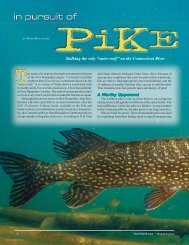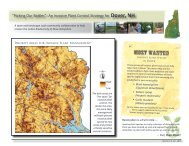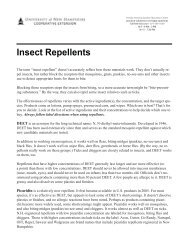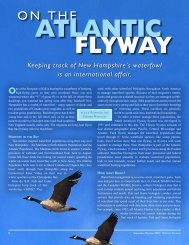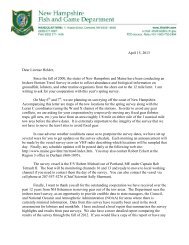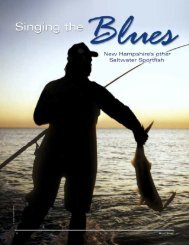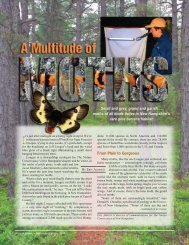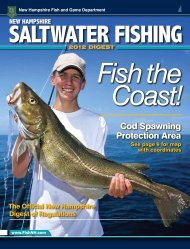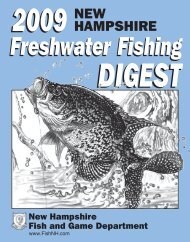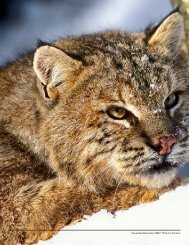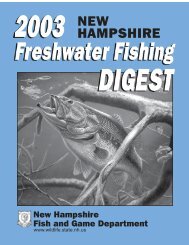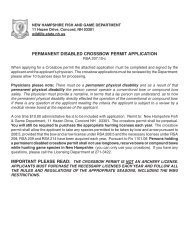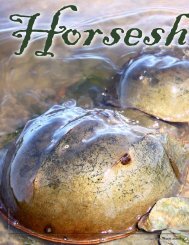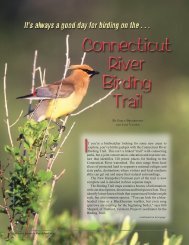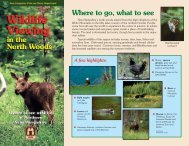Bonding with Blanding's Turtle - New Hampshire Fish and Game ...
Bonding with Blanding's Turtle - New Hampshire Fish and Game ...
Bonding with Blanding's Turtle - New Hampshire Fish and Game ...
- No tags were found...
Create successful ePaper yourself
Turn your PDF publications into a flip-book with our unique Google optimized e-Paper software.
Tracking an obscure<br />
turtle across nasty terrain<br />
can be an awful way to<br />
spend a day…but may<br />
yield great benefits to the<br />
turtle <strong>and</strong> other species.<br />
<br />
FIGURING OUT the<br />
habitat needs of <strong>New</strong><br />
<strong>Hampshire</strong>’s<br />
Bl<strong>and</strong>ing’s turtles sounds straightforward<br />
enough on paper: Capture<br />
some turtles, glue radio-transmitters<br />
onto their shells, let them loose. Then<br />
track the critters <strong>with</strong> h<strong>and</strong>-held<br />
receivers to plot their movements <strong>and</strong><br />
see what kinds of habitat they use.<br />
Take one soggy, sinking step into<br />
that habitat, <strong>and</strong> the challenge of such<br />
an undertaking becomes clear.<br />
Bl<strong>and</strong>ing’s turtles live in huge<br />
marshes full of scrubby shrubs,<br />
grasses <strong>and</strong> moss. Deep channels of<br />
water cut here <strong>and</strong> there, often<br />
obscured by vegetation. It takes a<br />
hearty soul – <strong>and</strong> waders – to get<br />
through these places.<br />
“The best way to describe what it’s<br />
like out there<br />
is that one<br />
minute<br />
you’re up on<br />
a hummock<br />
of dry grass,<br />
<strong>and</strong> the next<br />
minute<br />
Brenda Charpentier of Sanbornton writes<br />
for the Nongame <strong>and</strong> Endangered Wildlife<br />
Program’s newsletter, Wildlines.<br />
By Brenda Charpentier<br />
Nongame bioaide Jessana Palm (right <strong>and</strong> lower inset) braves the boggy wilds of<br />
Stark Pond Marsh in a quest for Bl<strong>and</strong>ing’s turtles.<br />
you’re waist-deep in your waders in<br />
water,” said John Kanter, the coordinator<br />
of <strong>Fish</strong> <strong>and</strong> <strong>Game</strong>’s Nongame<br />
<strong>and</strong> Endangered Wildlife Program.<br />
“You would not just go for a stroll in<br />
there. There are a lot of me<strong>and</strong>ering<br />
rivers <strong>and</strong> streams <strong>with</strong> a lot of beaver<br />
activity, interspersed <strong>with</strong> extensive<br />
wetl<strong>and</strong>s.”<br />
Kanter is coordinating a study of<br />
Bl<strong>and</strong>ing’s turtle habitat <strong>with</strong> researchers<br />
from UNH <strong>and</strong> the Audu-<br />
bon Society of <strong>New</strong> <strong>Hampshire</strong> <strong>and</strong><br />
volunteers, under a grant from the<br />
state’s Department of Environmental<br />
Services. The study is entering its<br />
third <strong>and</strong> final year <strong>and</strong> involves<br />
marshes in Dunbarton <strong>and</strong> Loudon<br />
<strong>and</strong> in the Great Bay area on the<br />
Seacoast.<br />
<br />
Little is known about Bl<strong>and</strong>ing’s<br />
turtles, but the species is thought to be<br />
14 May/June 2002 • WILDLIFE JOURNAL
MARRQUIS WALSH PHOTOS<br />
Biologist John Kanter<br />
prepares to release a<br />
turtle, which is being<br />
tracked by radiotelemetry<br />
to provide insight on its range <strong>and</strong><br />
habitats.<br />
in decline in <strong>New</strong> <strong>Hampshire</strong> <strong>and</strong> in<br />
much of its range <strong>and</strong> may need<br />
protection. That concern fits in <strong>with</strong><br />
the mission of the Nongame <strong>and</strong><br />
Endangered Wildlife Program, which<br />
is to conserve <strong>and</strong> protect the more<br />
than 400 species in the state not<br />
addressed by hunting or fishing<br />
conservation programs <strong>and</strong> funds.<br />
Bl<strong>and</strong>ing’s turtles use both<br />
wetl<strong>and</strong>s <strong>and</strong> upl<strong>and</strong> habitat (for egg<br />
laying), <strong>and</strong> so are “likely very<br />
susceptible to the negative pressures<br />
of development <strong>and</strong> fragmentation,”<br />
said Dr. Kim Babbitt, the lead UNH<br />
researcher on the project.<br />
One more reason to study<br />
Bl<strong>and</strong>ing’s turtles, Babbitt said, is<br />
that the number of eggs laid by<br />
females is relatively small. Females<br />
don’t start laying eggs until they’re<br />
anywhere from 14 to 20 years old,<br />
making the loss of adult females –<br />
because of roadkill, for example –<br />
particularly problematic.<br />
“Although not an objective of the<br />
study, we have gleaned that road<br />
mortality may be significant,” Babbitt<br />
said. “We or others found almost as<br />
many turtles dead on the road as we<br />
captured alive.”<br />
<br />
Finding <strong>and</strong> capturing a Bl<strong>and</strong>ing’s<br />
turtle alive is no small feat.<br />
“It’s like looking for a needle in a<br />
haystack,” said Jessana Palm, a bioaide<br />
<strong>with</strong> the Nongame <strong>and</strong> Endangered<br />
Wildlife Program who helped<br />
carry out the study. Traps baited <strong>with</strong><br />
cat food <strong>and</strong> sardines attracted some<br />
Bl<strong>and</strong>ing’s turtles, but mostly painted<br />
<strong>and</strong> snapping turtles, Palm said. So<br />
she <strong>and</strong> other searchers often ended<br />
up walking the marshes in the vicinity<br />
of other known Bl<strong>and</strong>ing’s turtles in<br />
hopes of catching some by h<strong>and</strong>.<br />
Sometimes, Palm literally fell into<br />
a find. At a Dunbarton marsh called<br />
Great Meadows, she was hopping<br />
from hummock to hummock, trying to<br />
keep herself level in the up-<strong>and</strong>-down<br />
terrain. “At one point I took a step <strong>and</strong><br />
didn’t make it to the next hummock<br />
continued on next page<br />
WILDLIFE JOURNAL • May/June 2002 15
continued from previous page<br />
<strong>and</strong> fell in. When I looked up, there<br />
was a turtle right in front of me. That<br />
happened twice.”<br />
Challenges not<strong>with</strong>st<strong>and</strong>ing, the<br />
researchers fitted 20 Bl<strong>and</strong>ing’s<br />
turtles <strong>with</strong> radio transmitters. They<br />
are glued directly to the back of the<br />
top shell, where they look like little<br />
license plates <strong>with</strong> antennae.<br />
The turtles’ movements will be<br />
tracked for the third season this spring<br />
<strong>and</strong> summer. Researchers will go to<br />
the marshes <strong>with</strong> h<strong>and</strong>-held receivers<br />
<strong>and</strong> listen for the radio transmitters’<br />
beeps, following their increasing<br />
strength until they pinpoint the<br />
critters’ exact locations. They’ll take<br />
GPS readings at those spots, <strong>and</strong> the<br />
results will be charted <strong>and</strong> compared<br />
to maps of habitat types to get a good<br />
picture of turtle movements <strong>and</strong><br />
critical habitat.<br />
<br />
Spring is when the turtles are really<br />
on the move, as the females amble out<br />
of the wetl<strong>and</strong>s looking for s<strong>and</strong>y areas<br />
on higher ground to lay their eggs.<br />
“Our farthest-traveling turtle (so<br />
far) went about 2 miles, moving<br />
between where she spent most of her<br />
time <strong>and</strong> where she nested,” Kanter<br />
said.<br />
<br />
If you see a turtle <strong>with</strong> a bright yellow chin <strong>and</strong> a domed, helmet-like shell,<br />
it’s a Bl<strong>and</strong>ing’s turtle, one of seven turtle species in the state. These critters<br />
live primarily in large wetl<strong>and</strong>s in the southeastern part of the state. Their<br />
wider range stretches as far west as Minnesota, south to Missouri <strong>and</strong> north<br />
to Ontario, Canada. They are apparently secure in Ontario <strong>and</strong> Nebraska,<br />
but everywhere else their status ranges from “vulnerable” to “imperiled.”<br />
Natural threats to the turtles’ survival abound. Foxes, skunks, raccoons<br />
<strong>and</strong> badgers eat their eggs; fish, mammals <strong>and</strong> birds eat their hatchlings. In<br />
one 1983 study in Michigan, researchers found that their study subjects had<br />
only an 18 percent chance of successfully hatching <strong>and</strong> emerging from their<br />
nests. With predators so successful,<br />
human development can easily push<br />
a species over the edge.<br />
Bl<strong>and</strong>ing’s turtles live for several<br />
decades. Scientists believe the<br />
Middle-schoolers from an Audubon<br />
Society of <strong>New</strong> <strong>Hampshire</strong><br />
program learn about the<br />
Bl<strong>and</strong>ing’s research project.<br />
Males, too, seem to need a wide<br />
area to roam. One male in the study<br />
ranged about 84 acres. “This male<br />
used large, beaver-impounded<br />
wetl<strong>and</strong>s <strong>and</strong> vernal pools, <strong>and</strong><br />
traveled over broad upl<strong>and</strong> areas,”<br />
Babbitt said. “Why did he do this<br />
Well, part of the answer was that he<br />
mated <strong>with</strong> several females who were<br />
located in different wetl<strong>and</strong>s.”<br />
It’s too early to draw firm conclu-<br />
<br />
The Nongame <strong>and</strong> Endangered Wildlife Program wants you to<br />
“stick your neck out” this spring <strong>and</strong> make a contribution to the<br />
2002 Annual Fund Campaign. By sticking your neck out, you<br />
will help us protect <strong>and</strong> study the Bl<strong>and</strong>ing’s turtle.<br />
These turtles have unusually long necks that enable them<br />
to extend their heads to the water’s surface while keeping their bodies<br />
submerged <strong>and</strong> out of sight.<br />
Your donation each year to the Annual Fund Campaign means much<br />
more than helping us protect one special species. Your financial support is<br />
the cornerstone of our work. You provide the resources, confidence <strong>and</strong><br />
optimism that has helped us build a highly effective <strong>and</strong> strategic program<br />
over the last 13 years. Your gift also helps us meet our annual $50,000<br />
matching grant from the state. As you know, we receive no funds from sport<br />
licenses or tax check-offs like other states. We depend on you.<br />
When you receive the Nongame Program’s appeal in the coming weeks,<br />
please “stick your neck out” <strong>and</strong> support the 2002 Annual Fund Campaign.<br />
The annual campaign ends on June 30. Help us protect the nongame wildlife.<br />
For more information, call the program at 603-271-2461, or visit<br />
www.wildlife.state.nh.us. ■<br />
MARQUIS WALSH PHOTO<br />
species has been around since<br />
before the age of the dinosaurs.<br />
Archeologists have found Bl<strong>and</strong>ing’s<br />
shells that were used by early<br />
Indians as tools.<br />
Bl<strong>and</strong>ing’s turtles eat pondweed<br />
seeds <strong>and</strong> other wetl<strong>and</strong>s plant<br />
matter, small fish <strong>and</strong> crayfish,<br />
insects <strong>and</strong> earthworms. They mate<br />
from March to May <strong>and</strong> lay their eggs<br />
in mid-June <strong>and</strong> into July. ■<br />
sions from this study, but the great<br />
distances the turtles are traveling<br />
shows the importance of protecting<br />
large, unbroken tracts of l<strong>and</strong> that<br />
include both wetl<strong>and</strong>s <strong>and</strong> upl<strong>and</strong>s,<br />
Kanter said: “Big is definitely better.”<br />
<br />
Future protection measures could<br />
include tunnels under roads in prime<br />
Bl<strong>and</strong>ing’s turtle habitat <strong>and</strong> encouraging<br />
town <strong>and</strong> city planners to take<br />
the species into consideration when<br />
planning roads <strong>and</strong> other development.<br />
“That decision whether to put a<br />
new road in an area – it’s got to be<br />
one of the most critical l<strong>and</strong>-use<br />
decisions people will be making,”<br />
Kanter said.<br />
Tracking Bl<strong>and</strong>ing’s turtles to<br />
identify prime habitat is just the first<br />
step toward conserving the species, as<br />
well as others that use the same<br />
habitat, like beaver, ducks, amphibians,<br />
fish <strong>and</strong> assorted reptiles.<br />
“Now we need to get together <strong>with</strong><br />
local l<strong>and</strong> conservation groups,” said<br />
Kanter, “<strong>and</strong> say ‘Look here, you’ve<br />
got a great population of this species.<br />
Think about protecting these areas,<br />
<strong>and</strong> that will protect a whole lot of<br />
other species, too.’ ” ■<br />
16 May/June 2002 • WILDLIFE JOURNAL



